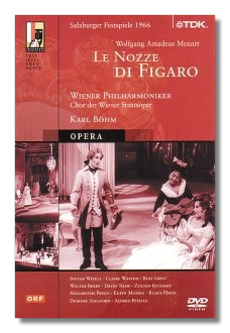
The Internet's Premier Classical Music Source
Related Links
- Mozart Reviews
- Latest Reviews
- More Reviews
-
By Composer
-
Collections
DVD & Blu-ray
Books
Concert Reviews
Articles/Interviews
Software
Audio
Search Amazon
Recommended Links
Site News
 DVD Review
DVD Review
Wolfgang Mozart

Le nozze di Figaro
(The Marriage of Figaro)
1966 Salzburg Festival
- Walter Berry (Figaro)
- Claire Watson (Countess Almaviva)
- Reri Grist (Susanna)
- Ingvar Wixell (Count Almaviva)
- Edith Mathis (Cherubino)
- David Thaw (Basilio)
- Zoltán Kelemen (Bartolo)
Choir of the Vienna State Opera
Vienna Philharmonic Orchestra/Karl Böhm
TDK DVUS-CLOPNDF 2DVDs monaural/B&W 180min
You'll easily find a better photographed Nozze, or one with better sound, or one more splendidly staged, but it will be difficult to find one that is more authentically Mozartean than this one. The date was August 11, 1966, and the venue was the Kleines Festspielhaus of the Salzburg Festival. This was a new production by stage director Günther Rennert, and a practically whole new generation of Mozart singers was enlisted to make it come to life.
Karl Böhm had been conducting Nozze at Salzburg since 1941. He performs the neat trick of giving the production its soul and backbone without calling attention to himself. Everything he does is perfectly judged and singer-friendly, and the opera's human (and humane) comedy is very much at the forefront.
The cast is just about perfect too. These singers all were superb exponents of Mozartean style, and all pretty much were at the peak of their careers. Reri Grist is an adorable but not twittery Susanna, and the creamy-voiced Edith Mathis is a playful and credible Cherubino – very much the young teenager whose hormones have a mind of their own. Claire Watson is a cool and aristocratic Countess; she misses some of the character's porcelain sadness. Among the men, Walter Berry excels with his richly-sung and clever Figaro. His aria railing against women in the final act comes off particularly well. Wixell's Count is another fine piece of vocalism and acting; like the Countess, we forgive him at the end because of his charm, and because we feel that he has grown wiser through this day of madness. The supporting cast is exceptionally fine too.
The one drawback about this production is the set design. Ludwig Heinrich seems to have had a field day at the Austrian equivalent of Wal-Mart – this isn't shabby chic, it's just shabby. The last act's garden is really nothing more than a maze of screens with fake foliage stuck on. Count Almaviva's household need not be opulent, but there needs to be some evidence that the Count is a man with power, otherwise the drama doesn't make a lot of sense.
The sound, while monaural, is free of distortion and excellently balanced. The video portion of this production has aged a little less well. Apart from being in black-and-white, there are some intermittent (but minor) problems with visual noise. The audio and video shortcomings are not enough to get in the way of the performance, however.
There is no bonus material and I question why two DVDs were needed – is 180 minutes of monaural, black-and-white material too long for a single DVD? Well, never mind, this is Nozze that will thrill anyone who treasures "the way we were."
Copyright © 2003, Raymond Tuttle


















